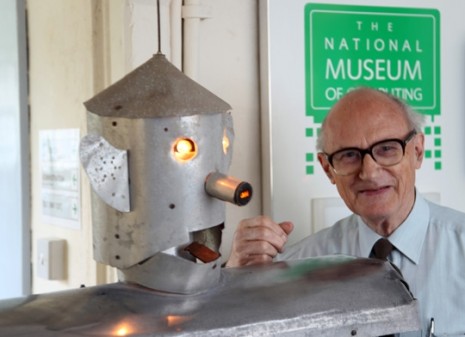
O boy, this was the kind of thing I wanted to make when I was about nine or ten, after watching too many episodes of Dr Who and Lost in Space, but found my imagination hindered by a lack of Meccano, and an excess of cardboard boxes and sticky-back plastic. Now it seems my childhood dream has come true as one of the UK’s first ever humanoid robots has been revived after spending forty-five years gathering dust in a garage.
Robot George wasn’t made by some sci-fi obsessed kid, but by a former spy catcher and RAF officer Tony Sale, who built this baby for around $25, using scrap metal form a crashed Wellington Bomber plane, back in 1950.
Sale was a fresh-faced 19-year-old at the time and his incredible, radio-controlled, man-sized robot, which looks like something from Flash Gordon, or even Flesh Gordon, could walk, apparently talk and carry out simplistic chores, as the Daily Telegraph reports:
“I made him in my spare time. He was 6ft tall and I put light sensitive cells in his eyes which enabled him to home in on an illuminated beer bottle,” he said.
“He was brought out and demonstrated at all the open days at RAF Debden and featured on Pathe News.”
The robot, which is powered by two motorcycle batteries can be made to walk, turn his head, move an arm and sit down. He can operate up to 30 feet from his controls.
He caught the imagination of the press and was featured in numerous papers as one of the earliest humanoid robots built in the UK.
George was pictured carrying the shopping, hoovering and even mowing the lawn.
“I think he really impressed people because he looked so lifelike,” said Mr Sale.
“Unfortunately I wasn’t able to improve him any further as computers weren’t developed enough at the time.
“He has no memory and there were no computers small enough to enable him to become an intelligent robot, so he was put away.
“He was left to languish until I found him again in my garage, where he hadn’t been touched for 45 years.”
However Robot George wasn’t Mr. Sale’s first attempt at building a robot, as this interview with the BBC explains:
Remarkably, George was not the first robot that Mr Sale had built. In fact, he was the fifth incarnation of a mechanical man that the young electronics wizard had put together.
Creating any kind of working robot in the early 1950s was an incredible feat, especially as Mr Sale was under 20 at the time. The version he produced then has a claim to be among the earliest humanoid robots built in the UK.
Mr Sale’s prowess with a spanner and soldering iron remained undimmed.
He was the driving force behind the rebuild of the famous Colossus computer and one of the founders of The National Museum of Computing at Bletchley Park, as well as being a British spy-catcher.












